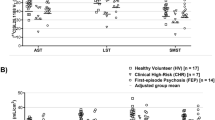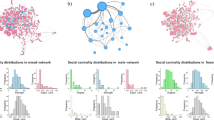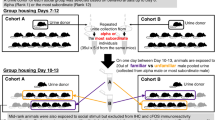Abstract
Social dominance is a fundamental component of both human and nonhuman primate sociality. However, its neurobiological correlates remain incompletely understood. We evaluated the association between dominance status and monoamine metabolite concentrations in cisternal cerebrospinal fluid (CSF) in adult male (n = 25) and female (n = 21) cynomolgus macaques (Macaca fascicularis) housed in unisexual social groups. Concentrations of the metabolites of dopamine (homovanillic acid [HVA]), norepinephrine (3-methoxy-4-hydroxyphenylglycol [MHPG]) and serotonin (5-hydroxyindoleacetic acid [5-HIAA]) were assayed. Dominant monkeys, both males and females, had significantly higher CSF HVA concentrations than did subordinates (p values < .05). Among males, but not females, dominants also had lower CSF 5-HIAA than subordinates (p < .05). The Dominance-HVA association observed here is consistent with recent speculation that social extraversion, a dominance-related personality trait in humans, may also reflect heightened central nervous system dopaminergic activity.
Similar content being viewed by others

Log in or create a free account to read this content
Gain free access to this article, as well as selected content from this journal and more on nature.com
or
References
Adams MR, Kaplan JR, Koritnik DR . (1985): Psychosocial influences on ovarian endocrine and ovulatory function in Macaca fascicularis. Physiol Behav 35: 935–940
Adler CM, Elman I, Weisenfeld N, Kestler L, Pickar D, Breier A . (2000): Effects of acute metabolic stress on striatal dopamine release in healthy volunteers. Neuropsychopharmacology 22: 545–550
Altmann J . (1974): Observational study of behavior: sampling methods. Behaviour 49: 337–367
Bernstein IS . (1976): Dominance, aggression and reproduction in primate societies. J Theor Biol 60: 459–472
Bernstein IS . (1981): Dominance: the baby and the bathwater. The Behavioral and Brain Sciences 4: 419–457
Bernstein IS, Cooper MA . (1999): Dominance in assamese macaques (Macaca assamensis). Am J Primatol 48: 283–289
Breier A . (1989): Experimental approaches to human stress research: Assessment of neurobiological mechanisms of stress in volunteers and psychiatric patients. Biol Psychiatry 26: 438–462
Butovskaya M, Kozintsev A, Welker C . (1995): Grooming and social rank by birth: the case of Macaca fascicularis. Folia Primatol 65: 30–33
Capitanio JP . (1999): Personality dimensions in adult male rhesus macaques: prediction of behaviors across time and situation. Am J Primatol 47: 299–320
Clarke AS, Boinski S . (1995): Temperament in nonhuman primates. Am J Primatol 37: 103–126
Clarke AS, Mason WA, Moberg GP . (1988): Interspecific contrasts in responses of macaques to transport cage training. Lab Anim Sci 38: 305–309
Cloninger CR . (1988): A unified biosocial theory of personality and its role in the development of anxiety states: a replay to commentaries. Psychiatr Dev 6: 83–120
Cohen S, Line S, Manuck SB, Rabin BS, Heise ER, Kaplan JR . (1997): Chronic social stress, social status, and susceptibility to upper respiratory infections in nonhuman primates. Psychosom Med 59: 213–221
Commissiong JW . (1985): Monoamine metabolites: their relationship and lack of relationship to monoaminergic neuronal activity. Biochem Pharmacol 34: 1127–1131
Depue RA . (1995): Neurobiological factors in personality and depression. European Journal of Personality 9: 413–439
Depue RA, Iacono WG . (1989): Neurobehavioral aspects of affective disorders. Annu Rev Psychol 40: 457–492
Depue RA, Luciana M, Arbisi P, Collins P, Leon A . (1994): Dopamine and the structure of personality: relation of agonist-induced dopamine activity to positive emotionality. J Pers Soc Psychol 67: 485–498
Drevets WC, Price JC, Kupfer DJ, Kinahan PE, Lopresti B, Holt D, Mathis C . (1999): PET measures of amphetamine-induced dopamine release in ventral versus dorsal striatum. Neuropsychopharmacology 21: 694–709
Eriksson E, Alling C, Andersch B, Andersson K, Berggren U . (1994): Cerebrospinal fluid levels of monoamine metabolites. A preliminary study of their relation to menstrual cycle phase, sex steroids, and pituitary hormones in healthy women and in women with premenstrual syndrome. Neuropsychopharmacology 11: 201–213
FitzGerald M, Malone KM, Li S, Harrison WM, McBride PA, Endicott J, Cooper T, Mann JJ . (1997): Blunted serotonin response to fenfluramine challenge in premenstrual dysphoric disorder. Am J Psychiatry 154: 556–558
Grant KA, Shively CA, Nader MA, Ehrenkaufer RL, Line SW, Morton TE, Gage HD, Mach RH . (1998): Effect of social status on striatal dopamine D2 receptor binding characteristics in cynomolgus monkeys assessed with positron emission tomography. Synapse 29: 80–83
Gray JA . (1987): The neuropsychology of emotion and personality. In Stahl SM, Iverson SD, Goodman EC, (eds), Cognitive Neurochemistry. Oxford, UK, Oxford University Press, pp 171–190
Gruen R, Baron M . (1984): Stressful life events and schizophrenia: Relation to illness onset and family history. Neuropsychobiology 12: 206–208
Hausfater G . (1975): Dominance and reproduction in baboons (Papio cynocephalus). Contrib Primatol 7: 1–150
Higley JD, Suomi SJ, Linnoila M . (1991): CSF monoamine metabolite concentrations vary according to age, rearing, sex, and are influenced by the stressor of social separation in rhesus monkeys. Psychopharmacology 103: 551–556
Higley JD, King ST Jr, Hasert MF, Champoux M, Suomi SJ, Linnoila M . (1996a): Stability of interindividual differences in serotonin function and its relationship to severe aggression and competent social behavior in rhesus macaque females. Neuropsychopharmacology 14: 67–76
Higley JD, Mehlman PT, Poland RE, Taub DM, Vickers J, Suomi SJ, Linnoila M . (1996b): CSF testosterone and 5-HIAA correlate with different types of aggressive behaviors. Biol Psychiatry 40: 1067–1082
Jibson M, Faull KF, Csernansky JG . (1990): Intercorrelations among monoamine metabolite concentrations in human lumbar CSF are not due to a shared acid transport system. Biol Psychiatry 28: 595–602
Kaplan JR, Manuck SB . (1989): The effect of propranolol on behavioral interactions among adult male cynomolgus monkeys (Macaca fascicularis) housed in disrupted social groupings. Psychosom Med 51: 449–462
Kaplan JR, Manuck SB, Clarkson TB, Lusso FM, Taub DM . (1982): Social status, environment, and atherosclerosis in cynomolgus monkeys. Arteriosclerosis 2: 359–368
Kaplan JR, Adams MR, Koritnik DR, Rose JC, Manuck SB . (1986): Adrenal responsiveness and social status in intact and ovariectomized Macaca fascicularis. Am J Primatol 11: 181–193
Kaplan JR, Manuck SB, Gatsonis C . (1990): Heart rate and social status among male cynomolgus monkeys (Macaca fascicularis) housed in disrupted social groupings. Am J Primatol 21: 175–187
Kaplan JR, Shively CA, Fontenot MB, Morgan TM, Howell SM, Manuck SB, Muldoon MF, Mann JJ . (1994): Demonstration of an association among dietary cholesterol, central serotonergic activity, and social behavior in monkeys. Psychosom Med 56: 479–484
Kaplan JR, Adams MR, Anthony MS, Morgan TM, Manuck SB, Clarkson TB . (1995): Dominant social status and contraceptive hormone treatment inhibit atherogenesis in premenopausal monkeys. Arterioscler Thromb Vasc Biol 15: 2094–2100
Kaplan JR, Fontenot MB, Manuck SB, Muldoon MF . (1996): The influence of dietary lipids on agonistic and affiliative behavior in Macaca fascicularis. Am J Primatol 38: 333–347
Kaplan JR, Phillips-Conroy J, Fontenot MB, Jolly CJ, Fairbanks LA, Mann JJ . (1999): Cerebrospinal fluid monoaminergic metabolites differ in wild anubis and hybrid (anubis-hamadryas) baboons: possible relationships to life history and behavior. Neuropsychopharmacology 20: 517–524
Lewis MH, Gluck JP, Beauchamp AJ, Keresztury MF, Mailman RB . (1990): Long-term effects of early social isolation in Macaca multatta: changes in dopamine receptor function following apomorphine challenge. Brain Res 513: 67–73
Manuck SB, Flory JD, McCaffery JM, Matthews KA, Mann JJ, Muldoon MF . (1998): Aggression, impulsivity, and central nervous system serotonergic responsivity in a nonpatient sample. Neuropsychopharmacology 19: 287–299
Netter P, Rammsayer T . (1991): Reactivity to dopaminergic drugs and aggression-related personality traits. Personality and Individual Differences 12: 1009–1017
Ortiz J, Fitzgerald LW, Lane S, Terwilliger R, Nestler EJ . (1996): Biochemical adaptations in the mesolimbic dopamine system in response to repeated stress. Neuropsychopharmacology 14: 443–452
Posener JA, Schatzberg AF, Williams GH, Samson JA, McHale NL, Bessette MP, Schildkraut JJ . (1999): Hypothalamic-pituitary-adrenal axis effects on plasma homovanillic acid in man. Biol Psychiatry 45: 222–228
Raleigh MJ, Brammer GL, McGuire MT . (1983): Male dominance, serotonergic systems, and the behavioral and physiological effects of drugs in vervet monkeys (Cercopithecus aethiops sabaeus). Prog Clin Biol Res 131: 185–197
Raleigh MJ, McGuire MT, Brammer GL, Pollack DB, Yuwiler A . (1991): Serotonergic mechanisms promote dominance acquistion in adult male vervet monkeys. Brain Res 559: 181–190
Raleigh MJ, Brammer GL, McGuire MT, Pollack DB, Yuwiler A . (1992): Individual differences in basal cisternal cerebrospinal fluid 5-HIAA and HVA in monkeys. The effects of gender, age, physical characteristics, and matrilineal influences. Neuropsychopharmacology 7: 295–304
Sade D . (1967): Determinants of dominance in a group of free-ranging rhesus monkeys. In Altmann S (ed), Social Communication among Primates. New York, Academic Press, pp 99–114
Sade DS . (1973): An ethogram for Rhesus monkeys. I. Antithetical contrasts in posture and movement. Am J Phys Anthropol 38: 537–542
Scheinin M, Chang WH, Kirk KL, Linnoila M . (1983): Simultaneous determination of 3-methoxy-4-hydroxyphenylglycol, 5-hydroxyindoleacetic acid, and homovanillic acid in cerebrospinal fluid with high performance liquid chromatography using electrochemical detection. Anal Biochem 131: 246–253
Shively CA . (1998): Social subordination stress, behavior, and central monoaminergic function in female cynomolgus monkeys. Biol Psychiatry 44: 882–891
Shively C, Kaplan J . (1984): Effects of social factors on adrenal weight and related physiology of Macaca fascicularis. Physiol Behav 33: 777–782
Shively CA, Kaplan JR . (1991): Stability of social status rankings of female cynomolgus monkeys, of varying reproductive condition, in different social groups. Am J Primatol 23: 239–245
Shively CA, Fontenot MB, Kaplan JR . (1995): Social status, behavior and central serotonergic responsivity in female cynomolgus monkeys. Am J Primatol 37: 333–339
Silk JB . (1987): Social behavior in evolutionary perspective. In Smuts BB, Cheney DL, Seyfarth RM, Wrangham RW, Struhsaker TT (eds), Primate Societies. Chicago, The University of Chicago Press, pp 318–329
Sumiyoshi T, Yotsutsuji Y, Kurachi M, Itoh H, Kurokawa K, Saitoh O . (1998): Effect of mental stress on plasma homovanillic acid in healthy human subjects. Neuropsychopharmacology 19: 70–73
Walters JR, Seyfarth RM . (1987): Conflict and cooperation. In Smuts BB, Cheney DL, Seyfarth RM, Wrangham RW, Struhsaker TT (eds), Primate Societies. Chicago, The University of Chicago Press, pp 306–317
Welker C, Luhrmann B, Meinel W . (1979): Behavioral sequences and strategies of female crab-eating macaques, Macaca fascicularis Raffles, 1821, during group formation studies. Behavior 10: 219–237
Wiggins JS, Pincus AL . (1992): Personality: structure and assessment. Annu Rev Psychol 43: 473–504
Wiggins JS, Trapnell PD . (1996): A dyadic-interactional perspective on the five-factor model. In Wiggins JS (ed), The Five-Factor Model of Personality. New York, The Guilford Press, p 88
Yodyingyuad U, de la Riva C, Abbott DH, Herbert J, Keverne EB . (1985): Relationship between dominance hierarchy, cerebrospinal fluid levels of amine transmitter metabolites (5-hydroxyindole acetic acid and homovanillic acid) and plasma cortisol in monkeys. Neurosci 16: 851–858
Zuckerman M . (1991): Psychobiology of Personality. Cambridge, UK, Cambridge University Press
Zuckerman M . (1995): Good and bad humors: biochemical bases of personality and its disorders. Psychological Science 6: 325–332
Acknowledgements
Research was supported by the following grants: MH 46745 (JJM), HL 40962 (SBM), HL 45666 (JRK).
Elizabeth Nicks, Dewayne Cairnes, and Melissa Ayers aided in the collection of cerebrospinal fluid. Yung-yu Huang measured the metabolite concentrations in cerebrospinal fluid.
Author information
Authors and Affiliations
Corresponding author
Rights and permissions
About this article
Cite this article
Kaplan, J., Manuck, S., Fontenot, M. et al. Central Nervous System Monoamine Correlates of Social Dominance in Cynomolgus Monkeys (Macaca fascicularis). Neuropsychopharmacol 26, 431–443 (2002). https://doi.org/10.1016/S0893-133X(01)00344-X
Received:
Revised:
Accepted:
Published:
Issue date:
DOI: https://doi.org/10.1016/S0893-133X(01)00344-X
Keywords
This article is cited by
-
Intronic Tandem Repeat in the Serotonin Transporter Gene in Old World Monkeys: a New Transcriptional Regulator?
Journal of Molecular Neuroscience (2012)
-
Distinct physiological and behavioural functions for parental alleles of imprinted Grb10
Nature (2011)


